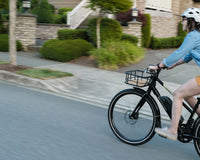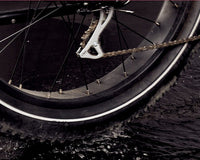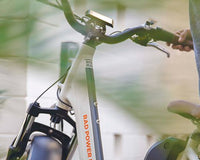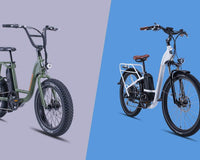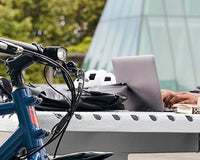As the sun starts rising later and setting earlier, the rains return, and the wind bites as you ride, you might think that the season for biking is over. With the proper know-how and practice, winter riding can actually be some of the most rewarding. I have been commuting by bike for years, all throughout every month. Here are my tips to help make the experience a good one.
For some, the idea of bundling up and getting in the saddle during the winter months seems preposterous. “Why would I subject myself to that?” people ask.
The answer lies in the same benefits that are felt year-round. You need not sit in traffic, or pay for gas, oil, jump-starts, or tow trucks. The health benefits of riding continue as well. Exercising regularly boosts your immune system and riding in the winter can improve your endurance. The going is often slower so it’s likely to take a bit longer to get from point A to point B, so riders need to be more attentive on the bike, which also means that your muscles will be engaged in keeping you upright and strengthening your core, something that won’t happen on the trainer. When it’s cold out, you also get more bang for your buck because your body will be working harder to stay warm.
Regardless of the weather, you benefit greatly by riding a bike more. The exercise alone is an almost unimaginable reward. Instead of sedentary transport by car, the very act of going from place to place by bike gets your heart pumping, blood flowing and the calories burning. And even beyond that, user volume on trails, bike paths, and biking routes decline making it easier and more peaceful to ride. There is nothing like riding through the peace and solitude of early morning snow.

Getting Started
Cycling in the fall and winter is by no means an all or nothing endeavor. You can start slowly and build confidence along the way.
Public transportation is a great way to cut the commute in half to reduce the starting mileage or time outside, but also if the weather just gets too bad, public transport is often a cheaper and safer alternative. Riders can also elect to ride just a few days per week instead of every day. Or even ride one morning, take the transit home and back the next day, and then ride the bike home from work on a later day in the week.
There are a few further things to consider when you ride year-round. These are fundamental regardless of where you live, although some become more integral in colder and snowy climates.
- You will need clothing and fuel to keep you warm and give you energy.
- Your bike should be outfitted according to the conditions and well maintained.
- You need to be aware of the hazard and obstacles involved. Winter riding calls for a different skill set and mentality than during the warmer months.
- You will need to increase regular maintenance to keep your bike clean and riding at its best.
1. Winter Cycling Clothing
The most important aspect of cold-weather riding is your clothing. It's also the area where most folks make mistakes. The key rule is to not overdress but not underdress. Since it is cold outside and there is no engine block kicking out heat, you tend to assume you need a ton of clothes. But, your body produces plenty of heat and sweat when riding, so you can quickly become too hot and sweaty. When riding an ebike it is important to keep in mind the level of effort you plan to utilize. If you are looking for a minimal effort ride you will want more clothing and layers, if you want a high effort ride you will want fewer layers. Also note that cotton can't keep you warm when it gets wet and you will get wet when riding in cold months (think road slush, rain, freezing rain, or just the sweat produced from riding). The way my father taught me was to never dress for just the first mile. Wear just enough clothes to be a bit cold when you start pedaling but keep in mind that you will warm up as you continue riding.
Outerwear
Cycling outerwear generally features a longer cut in the back and the sleeves as well as enhanced venting ability.
For cold, dry conditions: A soft-shell jacket makes a great outer layer. It will keep you warm and dry while allowing a little wind through, which helps counter the heat your body produces. In milder conditions, one might be able to use just a vest for a similar effect.
For cool, wet conditions: Riders in rainy areas require a good waterproof shell. Look for breathability and a longer cut in the back and arms so it won't ride up on you while cycling. You'll want the arms of your shell or jacket to be long enough to cover your wrists, or with Velcro on the wrists to create a rain-resistant seal, so that water doesn't trickle down your gloves. Vents are also helpful as they can help regulate body temperature. Most cycling specific rain shells come with two-way zippers. They allow you to zip open the jacket from the bottom while keeping your arms and upper torso covered. This is a tremendous way to shed heat and keep your ride comfortable. For pants, go oversized so that when you pedal, the pants don't lift over the opening in your shoe and dump water down your ankles.
Base Layer
The goal of a base layer is to keep you dry. Merino wool or any synthetic wicking fiber (such as polyester or nylon/spandex) works well. Again, cotton soaks up sweat and holds it next to your skin, so avoid it.
Head Coverage
Your head is often what a rider will forget. We lose large amounts of body heat from our heads. It is also near impossible to warm up again just with physical activity. A wool stocking cap or helmet liner worn under your helmet is sufficient for most days, with a balaclava or a scarf carried just in case. Just make sure the cap you wear is thin enough to fit under your helmet and not leave things bulky and uncomfortable while you ride.
Gloves
If rain is a factor, wear waterproof gloves. The best are cycling gloves with grippy palms and fingers since handlebars will be slippery when wet. Many companies make gloves suitable for cold-weather riding and the intended activity is not always the only use for the product. Look for gloves that have a waterproof liner sandwiched between insulated layers so they will keep your hands dry and warm in most conditions.
Footwear
The key to warm feet is to get some extra insulation into your footwear. Most clipless bike shoes tend to fit snug so that you are limited by the thickness of socks you can wear. I wear an oversized pair of shoes that I can use with thick, warm socks. I then slide on a pair of waterproof/windproof booties over those. A good rule of thumb is to go a half size bigger with your shoes. If you don't use clipless shoes and pedals, you can wear lightweight, waterproof boots or shoes that accommodate thick socks.

2. Winter Cycling Gear
Winter riding differs from that of summer not only in apparel but also in the gear you ought to have on your bike, particularly if you live in a snowy climate.
Bike Tires
Winter means slush or rain in many areas of the country, so make sure your tires offer good traction on wet surfaces. It is generally accepted that running tires at a lower pressure than you do in summer months will help. Just like with a car tire, reduced pressure makes a bike tire squish out a little bit and gain better traction. For snowy roads, some people like mountain bike tires for all conditions, others like big, fat, knobby ones to gain even more traction and float over the slush, snow, sand, and grit below.
For incredibly nasty conditions, you can find a few companies out there who make studded tires for both road and mountain bikes. These offer little metal projections protruding from the tire every inch or so. They are basically a built-in traction device for riding through snow and over ice. They work much like studded tires do on a car.
Bike Lighting
Daylight is hard to come by in the winter. It is pretty safe to assume you will always be riding in darkness, so you should have bright lights for both the front and back of the bike. I use a couple of LED lights—a white one in the front and two red in the back, plus I put one on the tail of my bike and another on the bag I carry.
Look for high powered bike lights, preferably those that cast a wide lighting angle. Rechargeable lighting systems work the best but generally cost more. The less-expensive clip-on variety work well, too. Just keep the batteries fresh so they are at their brightest. Visibility is important for safety. It sounds like a basic idea, but on a snowy January morning, you might not realize how much you can fade into a snowy, whitewashed landscape. In general, I find that cars are much more respectful of keeping their distance in the winter months, but do all you can to help them see you even if it's not dark yet.
Fenders
Tires are guaranteed to throw slush, snow, or rain up at you. Even if you're covered in Gore-Tex garments, the cold liquid will get heavy and start to pull heat away from your body. Fenders don't have to be extravagant, just basic enough to keep spray debris from hitting you. Front fenders should reach a couple of inches in front of and behind your fork. Rear fenders should either be full length, or if a clip-on variety is used, have the ability to angle up to compensate for less length. Our RadCity and RadWagon models come equipped with fenders. Fenders for the RadRover and RadMini are sold separately.

3. Winter Riding Skills
Another major difference between summer and winter riding is how you ride.
Lane Position
In winter, one of the most dangerous places to ride is right up next to the curb. In snowy climates, the gutter area is where snow accumulates, gets plowed over, melts, freezes, and generally becomes an uneven mess of differing pavement, road debris, and ice. Seek out the pavement or just far enough away from the curb to stay off of this dangerous mix. Cars tend to give you a wider berth in winter, so don't fear taking up a lane. Safety is more important than convenience. If you can't take the lane for any reason, then find the most untracked snow you can and take it a little slower. In wet or cool conditions, the immediate curb area is where broken glass, bits of rusted metal from cars, and general road debris build up as the rain washes it to the shoulder. This stuff will make an unpleasant riding experience and can puncture your tires. As with your spring-through-fall rides, you should always ride safely and in a predictable manner. Limit any sudden or erratic movements and use hand signals when turning or changing lanes and obey all relevant traffic and use laws.
Body Position
With all of the new hazards it may be hard to do so, but stay relaxed. With locked knees and elbows, you might find that a little ice ball or debris can be enough to send you toppling to the ground. Instead, stay loose and use your legs to absorb any movement created by running over debris or similar dangerous areas. Be alert and still be ready to dodge any hazards or larger debris.
Ice Considerations
Watch out for areas with melted snow or ice pockets. Any water may be liquid by day in the sun, but will freeze in lower temperatures or as the sun sets. These are likely places to find black ice, which, as with driving, is probably the single most dangerous aspect of riding a bike in below-freezing conditions. In icy conditions, ride slowly and steadily through it.
4. Post-Ride Maintenance Tips
Winter is tough on a bike's exposed drivetrain. There is just too much sand, salt, and debris on the road to keep your chain and derailleur free and working. Gears tend to get gummed up after only a week or so in some areas. With all the grime on the road, any bike will soon start to squeak, click, clatter, and make noises you did not think capable. Even in areas where the temperatures don't get below freezing, the winter months tend to bring rain. Rain washes dirt and grime onto the road most likely where you are riding and you will find your wheels will throw it into your bike's drivetrain. If you do ride your bike throughout the winter, you should plan to frequently wash and lubricate your drivetrain. The more moving or exposed parts, the more places that sand, salt, and dirt can gather and affect performance. By minimizing rust and dirt accumulation, you'll keep everything much happier and smoother. To do so, get in the habit of cleaning your chain and drivetrain after almost every ride. A chain cleaner, rag, and an old toothbrush are all you need. Just clean it up and re-grease it with a chain lube designed for your climate. Wipe down your brakes after snowy or dirty rides and make sure the contact surfaces with the wheels are clean. With disc brakes, avoid touching the rotors or brake pads with your bare hands as the oils in your skin will leave a residue and it can create issues with braking power.
Riding your bike or electric bike year-round presents different challenges and rewards than one might face in a three-season commute or riding schedule. The hardest thing for most folks is figuring out the logistics of riding in different weather patterns. Once you have a feel for what you need, it really becomes second nature and, if anything, it leaves you in better spirits throughout the day and makes you a better rider year-round!




